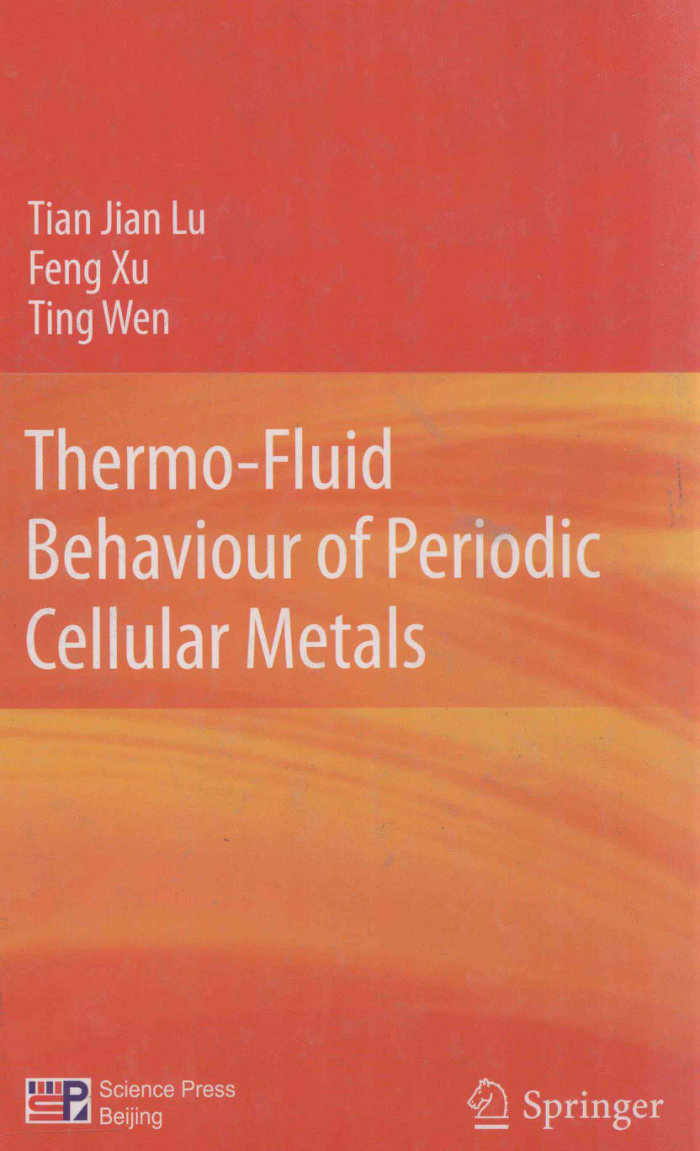您当前的位置:首页>金属工艺>周期性多孔金属材料的热流性能(英文版)
内容简介
 周期性多孔金属材料的热流性能(英文版)
周期性多孔金属材料的热流性能(英文版)作者:卢天健 著
出版时间:2013年
内容简介
《周期性多孔金属材料的热流性能》在揭示多功能超轻周期性多孔金属材料和结构在强制对流条件下传热传质机理,为研制以多功能超轻多孔材料为基本材料、具有优良传热性能和力学性能的高效紧凑式换热器、微热管等提供理论依据和指导。
目录
Chapter 1 Introduction
1.1 Introduction and Synopsis
1.2 Cellular Solids
1.3 Periodic Cellular Solids
1.3.1 2D periodic cellular solids
1.3.2 3D periodic cellular solids
1.4 Multifunctional Applications
1.5 Aims and Outline of the Book
References
Chapter 2 Experimental and Numerical Methods
2.1 Introduction
2.2 Experimental Methods
2.2.1 Experimental setup
2.2.2 Experimental procedure
2.2.3 Data analysis
2.3 Numerical Method
2.3.1 Computational domain
2.3.2 Mesh generation
2.3.3 Physical boundary conditions
2.3.4 CFD solver
2.3.5 Mesh sensitivity
References
Chapter 3 2D Periodic Cellular Metals
3.1 Introduction and Synopsis
3.2 Characterization and Fabrication of 2D Cellular Solids..
3.2.1 What are 2D cellular solids
3.2.2 Characterizing 2D cellular solids
3.2.3 Fabrication of 2D cellular solids
3.3 Mechanical Properties of 2D Cellular Metals
3.3.1 General mechanical behaviour
3.3.2 Comparisons of 2D cellular metals with different cell shapes
3.3.3 Comparisons of 2D cellular metals with other cellular metals
3.4 Fluid-Flow Behaviour and Pressure Loss
3.4.1 Local pressure loss
3.4.2 FrictionM pressure loss
3.4.3 Overall pressure loss
3.5 Heat Transfer
3.5.1 Conjugated conduction-convection heat transfer process
3.5.2 Local temperature and heat flux distributions
3.5.3 Overall heat transfer characteristics
3.6 Summary
References
Chapter 4 3D Periodic Cellular Metals I. Textile
4.1 Introduction and Synopsis
4.2 Characterization and Fabrication of Woven Textiles
4.2.1 Topology of textile core
4.2.2 Porosity and surface area density
4.2.3 Fabrication
4.3 Mechanical Properties of Woven Textiles
4.4 Flow and Pressure Loss Behaviour
4.4.1 Model
4.4.2 Experimental result
4.5 Heat Transfer
4.5.1 Effective thermal conductivity
4.5.2 Convective heat transfer
4.5.3 Volumetric heat transfer coefficient
4.6 Summary
References
Chapter 5 3D Periodic Cellular Metals II. Lattice-Frame Materials
5.1 Introduction and Synopsis
5.2 Characterization and Fabrication of Lattice-Frame Materials(LFMs)
5.2.1 Topology
5.2.2 Manufacturing process
5.3 Mechanical Properties of the LFM
5.4 Fluid Flow Behaviour in the Lattice-Frame Material
5.4.1 Fluid-flow in the lattice-frame material
5.4.2 Flow in x-y plane
5.4.3 Flow on strut surfaces
5.4.4 Fluid-flow in the LFM
5.4.5 Surface flow patterns on the endwall plates
5.5 Pressure Loss Behaviour in the Lattice-Frame Material
5.5.1 Pressure loss per unit cell
5.5.2 Pressure loss mechanisms in the LFM
5.5.3 Effects of topological parameters on the overall pressure losses
5.6 Heat Transfer
5.6.1 Introduction
5.6.2 Thermo-fluid characterisation of the LFM
5.6.3 Local temperature distribution in forced air convection
5.6.4 Overall heat transfer behaviour
5.6.5 Effect of entry and exit regions on the overall endwall heat transfer
5.6.6 Effects of thermal conductivity on the overall heat transfer
5.6.7 Heat transfer due to flow mixing vs. convection from extended surface
5.6.8 Endwall surface heat transfer distribution
5.6.9 Details of the heat transfer on the strut surfaces (Orientation A)
5.6.10 Vortex structures in heat transfer
5.6.11 Contribution of the local flow features to the overall heat transfer
5.6.12 Effects of porosity and surface area density on the overall heat transfer
5.6.13 Optimum porosity for both the pressure loss and heat transfer in the LFM
5.7 Summary
5.7.1 Flow
5.7.2 Pressure loss
5.7.3 Heat transfer
5.7.4 The LFM as a multifunctional heat exchanger
References
Chapter 6 Overall Evaluation of Thermo-Fluid Performance
6.1 Introduction and Synopsis
6.2 Evaluation of Overall Pressure Loss
6.3 Evaluation of Overall Heat Transfer
6.4 Overall Thermo-Fluid Performance Evaluation
6.4.1 Thermal efficiency index
6.4.2 Comparisons of overall thermal performance
6.5 Summary
References
Chapter 7 Theoretical Analysis
7.1 Introduction and Synopsis
7.2 Fin Analogy Model of 2D Periodic Cellular Solids
7.2.1 Description of the problem
7.2.2 Case I——Isothermal surfaces
7.2.3 Case II——Constant heat flux surfaces
7.2.4 Optimal thermal design
7.3 Fin Analogy Model of 3D I. Woven Textile
7.3.1 Problem description
7.3.2 Governing equation of fin model
7.3.3 Overall heat transfer rate of woven textile
7.3.4 Model verification
7.3.5 Discussions
7.4 Fin Analogy Model of 3D II. Lattice-Frame Materials
7.4.1 Formulation of a governing fin equation
7.4.2 Empirical heat transfer data input
7.4.3 Model verification
7.4.4 Discussions
7.5 Analysis of 2D Periodical Cellular Metals with Developing Flow
7.5.1 Introduction
7.5.2 Problem description
7.5.3 Analysis
7.5.4 Validation of optimization analysis
7.5.5 Case studies and discussions
7.6 Summary
References
Chapter 8 Future
8.1 Multi-layered LFM
8.2 Optimal Design for 2D Cellular Materials
8.2.1 Optimal design of 2D cellular materials for multifunctional applications
8.2.2 Optimal design of 2D cellular materials with graded rectangular cells
8.3 Thermo-Fluid Characteristics of 2D Cellular Materials with Micro Cells
8.4 Heat Transfer Enhancement Techniques to 2D Cellular Metals
8.5 Woven Screens with Hollow Struts
8.6 Effects of Flow Unsteadiness on the Heat Transfer Enhancement
8.7 Multi-block 2D Periodic Cellular Metals
8.7.1 Pressure loss
8.7.2 Heat transfer
8.7.3 Multi-block: worthwhile or not
8.7.4 Conclusions
References
上一章:铸造感应电炉使用指导
下一章:铸坯成型理论